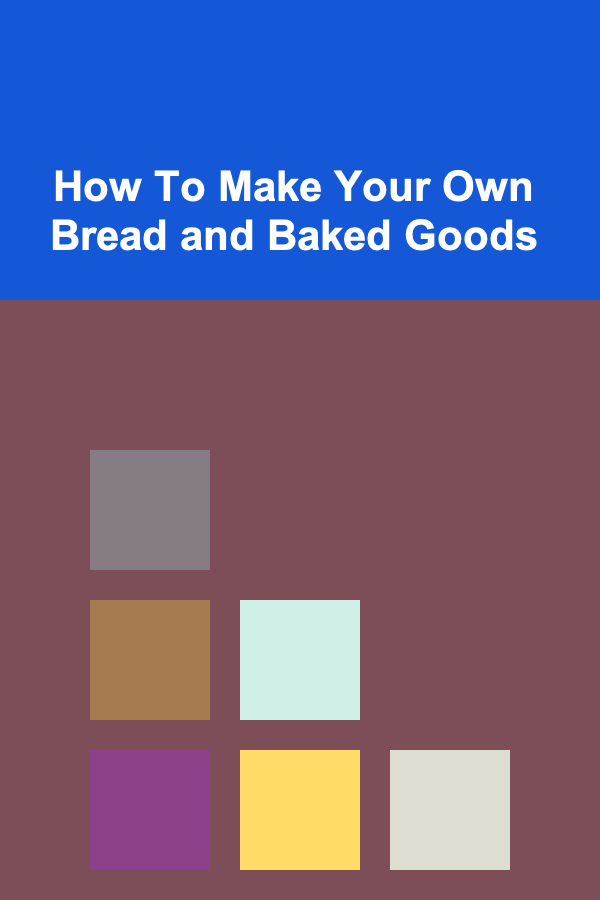
How To Make Your Own Bread and Baked Goods
ebook include PDF & Audio bundle (Micro Guide)
$12.99$5.99
Limited Time Offer! Order within the next:

Baking your own bread and baked goods is a rewarding and fulfilling experience. There's something special about the aroma of freshly baked bread filling the house, knowing you've crafted it from scratch. Whether you're interested in homemade bread for your sandwiches, pastries for a special occasion, or just to enjoy a homemade snack, the process can be surprisingly simple, yet deeply satisfying.
In this guide, we'll explore how to make your own bread and baked goods, step by step, covering the essentials like ingredients, techniques, tips, and common mistakes to avoid. By the end, you'll feel confident in your ability to bake your own delicious treats and customize them according to your taste.
The Basics of Bread Making
Bread making is an ancient art, with a rich history that dates back thousands of years. The process involves four primary components: flour, water, yeast, and salt. Each ingredient plays a crucial role in the final product, and understanding them will help you master the bread-baking process.
Key Ingredients
-
Flour Flour is the backbone of any bread recipe. It provides the structure and texture of the bread. The most common types of flour used in bread-making are:
- All-purpose flour: A versatile flour that can be used for most types of bread.
- Bread flour: Contains more gluten than all-purpose flour and gives bread its chewy texture.
- Whole wheat flour: Made from the entire wheat kernel, it offers a denser, more flavorful bread.
- Specialty flours: These include rye flour, spelt flour, and gluten-free flour, each adding distinct flavors and textures to the bread.
-
Water Water is essential for activating the yeast and forming gluten in the dough. The temperature of the water is important: too hot and it will kill the yeast, too cold and the yeast won't activate properly. A lukewarm temperature, between 100°F (37°C) and 110°F (43°C), is ideal for most bread recipes.
-
Yeast Yeast is the microorganism responsible for fermentation, which causes the dough to rise. There are two main types of yeast used in baking:
- Active dry yeast: This needs to be dissolved in warm water before use.
- Instant yeast: This can be mixed directly with the dry ingredients without needing to be dissolved first.
-
Salt Salt not only enhances the flavor of the bread but also strengthens the gluten structure and helps control the fermentation process. It should always be added after the yeast and water have been combined, as direct contact with salt can harm the yeast.
Tools and Equipment
Before you begin baking, it's important to gather the necessary tools. Here's a list of essential equipment for bread making:
- Mixing bowls: For combining your ingredients.
- Measuring cups and spoons: Accurate measurements are essential in baking.
- Dough scraper: For handling sticky dough and cleaning up surfaces.
- Baking sheet or bread pan: For baking your bread.
- A kitchen scale: Weighing ingredients, especially flour, provides more accurate results than volume measurements.
- A sharp knife or razor blade: For scoring the dough before baking, which helps the bread rise evenly.
The Bread-Making Process
Step 1: Mixing the Dough
To start, combine your dry ingredients (flour, salt, and yeast) in a large bowl. Create a well in the center and add your liquid ingredients, typically water and sometimes oil. If you're using active dry yeast, make sure to dissolve it in the warm water first. Gradually mix the ingredients together until a sticky dough begins to form. If the dough feels too dry, add a little more water; if it's too wet, add a bit more flour.
Step 2: Kneading the Dough
Once your dough is combined, the next step is to knead it. Kneading is the process of working the dough to develop the gluten, which gives the bread its structure. Turn the dough onto a floured surface and fold it over itself repeatedly, pressing it down and away from you with the palms of your hands. After about 8-10 minutes of kneading, the dough should be smooth, elastic, and slightly tacky, but not sticky.
Step 3: First Rise (Bulk Fermentation)
After kneading, place the dough in a lightly oiled bowl, cover it with a damp cloth or plastic wrap, and let it rest for about 1-2 hours. This is called the first rise or bulk fermentation. During this time, the yeast ferments the sugars in the dough, producing carbon dioxide gas that causes the dough to rise. The dough should double in size.
Step 4: Shaping the Dough
Once the dough has risen, it's time to shape it. Depending on the recipe, you can shape your dough into a round boule, a long baguette, or place it in a loaf pan. Shaping helps create tension in the dough's outer layer, which results in a better rise during baking.
Step 5: Second Rise (Proofing)
After shaping, allow the dough to rise a second time. This is the proofing stage, where the dough continues to expand and develop flavor. The second rise typically lasts 30 minutes to 1 hour. If you're making an enriched bread, such as a brioche, you may need to proof it for longer.
Step 6: Baking the Bread
Before placing the dough in the oven, make sure your oven is preheated to the correct temperature, usually between 375°F (190°C) and 475°F (245°C), depending on the type of bread. You can also add steam in the oven by placing a pan of water at the bottom or by spraying the bread with water just before baking. This creates a crispy, glossy crust.
Bake the bread for 25-45 minutes, depending on the size and type of bread. To check for doneness, tap the bottom of the loaf. If it sounds hollow, the bread is done. If not, give it a few more minutes.
Step 7: Cooling
Once your bread is baked, remove it from the oven and place it on a cooling rack. Let the bread cool completely before slicing. This resting period allows the bread to finish setting and ensures the texture will be perfect when you cut into it.
Other Types of Baked Goods
While bread is the most popular baked good, there are countless other delicious treats you can make at home. Here are a few ideas:
Pastries
Pastries are generally lighter and flakier than bread, thanks to the incorporation of fat. Some of the most popular pastry recipes include:
- Croissants: Made with layers of dough and butter, creating a light, flaky texture.
- Danish pastries: These often feature a sweet filling such as fruit or cream cheese.
- Puff pastry: A versatile dough used in both sweet and savory recipes, such as turnovers or cheese sticks.
Cakes
Cakes are another beloved type of baked good. They vary in texture from light and fluffy to dense and moist, and can be flavored in endless ways. Some popular cake types include:
- Chocolate cake: Rich, moist, and perfect for celebrations.
- Sponge cake: A light, airy cake that forms the base of many layered desserts.
- Carrot cake: A moist cake with carrots, nuts, and a sweet cream cheese frosting.
Cookies
Cookies are often smaller and sweeter than cakes and can be customized with a variety of add-ins. Some classic cookie recipes include:
- Chocolate chip cookies: A beloved American classic, chewy and filled with gooey chocolate chips.
- Sugar cookies: Simple, sweet, and often decorated with icing.
- Oatmeal raisin cookies: Hearty and wholesome, with oats and raisins mixed into the dough.
Scones and Biscuits
Scones and biscuits are similar, often made with the same basic ingredients but differ in texture. Scones are usually sweeter and may contain fruit or cream, while biscuits are savory and flaky, often served with butter or gravy.
Pies and Tarts
Pies and tarts involve a flaky pastry crust filled with either sweet or savory fillings. You can make:
- Apple pie: A classic American dessert with spiced apple filling in a flaky crust.
- Lemon meringue pie: A tangy filling topped with a fluffy meringue.
- Fruit tarts: A crispy pastry shell filled with custard or cream and topped with fresh fruit.
Tips for Success
- Use room temperature ingredients: For the best results, make sure your ingredients like butter, eggs, and milk are at room temperature, as they mix more easily.
- Weigh your ingredients: Baking is a science, and accurate measurements are crucial. A kitchen scale is your best friend.
- Don't rush the process: Bread making, in particular, requires patience. Don't be tempted to skip the rising times or cut corners---allow the dough to rise properly to achieve the best results.
- Experiment with flavors: Don't be afraid to add herbs, spices, or other flavorings to your dough. Ingredients like rosemary, garlic, and cheese can take your bread to the next level.
Common Mistakes to Avoid
- Over-kneading: While kneading is important, overworking the dough can make the bread dense and tough. Be sure to knead just until the dough is smooth and elastic.
- Underproofing: Failing to let the dough rise enough can result in dense, flat bread.
- Baking at the wrong temperature: Make sure your oven is preheated and at the right temperature for the type of bread or baked good you're making. An oven thermometer is a great investment.
- Not letting the bread cool: Cutting into bread while it's still hot can result in a gummy texture. Allow the bread to cool completely before slicing.
Conclusion
Baking your own bread and baked goods can be a fun and rewarding experience. With the right ingredients, tools, and techniques, you can create delicious homemade treats that are sure to impress your friends and family. From basic breads to elaborate pastries and cakes, there's a whole world of baking to explore. So, roll up your sleeves, get your hands in the dough, and start baking!

How to Market Your Cleaning Services to Local Clients
Read More
How to Maximize Small Entryways for Functionality
Read More
How to Utilize Grant Writing for Nonprofit Funding
Read More
The Art of Architecture: Techniques for Creating Sustainable and Aesthetic Designs
Read More
How to Participate in Decentralized Autonomous Organizations (DAOs)
Read More
Creating a Minimalist Morning Routine: A Guide to Clarity and Focus
Read MoreOther Products

How to Market Your Cleaning Services to Local Clients
Read More
How to Maximize Small Entryways for Functionality
Read More
How to Utilize Grant Writing for Nonprofit Funding
Read More
The Art of Architecture: Techniques for Creating Sustainable and Aesthetic Designs
Read More
How to Participate in Decentralized Autonomous Organizations (DAOs)
Read More